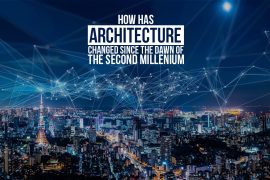Architecture has long been a symbol of human creativity and ingenuity, shaping the world around us in profound ways. Iconic buildings, with their distinctive designs and historical significance, often stand as testaments to human achievement. However, these architectural marvels can also serve as windows through which we can examine and reflect upon the societal norms, biases, and inequalities that have shaped their creation and impact. One compelling lens through which to explore these aspects is the intersection of gender and sexuality. By reinterpreting iconic buildings through a gender and sexuality lens, we can gain new insights into the multifaceted nature of our built environment.

Architectural designs are often influenced by prevailing cultural and societal norms, which can inadvertently reinforce traditional gender roles and expectations. When examining iconic buildings through a gender and sexuality lens, we can deconstruct the design choices to uncover hidden messages and power dynamics. For example, the phallic symbolism often associated with towering skyscrapers may reflect a historically male-dominated perspective on power and dominance. Moreover, the division of spaces within buildings can reveal implicit biases. Some historic structures may prioritize male-oriented spaces, such as grand entrance halls or boardrooms, while relegating female-oriented spaces, such as kitchens or nurseries, to secondary roles. This lens allows us to question why certain spaces were assigned specific functions based on gender stereotypes, and how this impacts the way we interact with our surroundings.
Reinterpreting iconic buildings through a gender and sexuality lens also provides an opportunity to “queer” the narrative, challenging traditional notions of heteronormativity and cisnormativity. By acknowledging the diverse identities and experiences of people within and outside the LGBTQ+ spectrum, we can reimagine the stories these buildings tell. Historical figures associated with these structures may have had identities that were concealed or marginalized, and understanding this aspect of their lives can enrich our understanding of their legacies. For instance, exploring the queer histories of well-known buildings can shed light on the contributions of LGBTQ+ individuals to architecture, design, and urban development. Recognizing their impact can lead to a more inclusive understanding of the architectural heritage that shapes our cities.

As we engage in the process of reinterpreting iconic buildings, we must also consider the potential for transformation. How can these structures be adapted to create more inclusive and affirming spaces? The challenge lies in striking a balance between preserving historical integrity and responding to contemporary needs for inclusivity. One way forward is through adaptive reuse, where iconic buildings are repurposed to serve new functions that align with modern values. For example, a historic building with a patriarchal history could be transformed into a community center that actively promotes gender equality and LGBTQ+ visibility. This approach not only honors the building’s legacy but also facilitates meaningful conversations about progress and social change.
Moreover, the demand for queer spaces, exemplified through community housing, remains significant due to the prevailing lack of societal acceptance within both families and neighborhoods. This is compounded by the unfortunate reality of many individuals facing exclusion and violence. An investigation conducted by the LGBT Youth Commission in 2016, involving peer research and analysis of existing studies by the Albert Kennedy Trust, revealed compelling statistics. It highlighted that a substantial 24% of young people identify as LGBT, and a distressing 69% of homeless LGBT youth have encountered instances of violence, abuse, or familial rejection. Astonishingly, 77% of these individuals attribute their homelessness to their LGBT identity. In light of these findings, the imperative of ensuring equitable access to suitable housing for queer individuals remains an urgent and critical concern.
While the primary focus might seem to be on housing solutions for queer youth, there is also a crucial need for housing options designed specifically for queer older adults. Research indicates that as much as 53% of the LGBTQ+ population faces social isolation. In December 2019, another facility tailored to meet the needs of queer elders was introduced. Named Stonewall House as a tribute to the renowned Stonewall Inn, this 17-story, 124,000 square foot mixed-use building was crafted by Marvel Architects. It holds the distinction of being the largest elder housing development that warmly welcomes the LGBT community in the country.

Reinterpreting iconic buildings through a gender and sexuality lens encourages society to engage in critical dialogue and reflection. It prompts us to question the structures that shape our physical environments, challenging us to consider how these spaces can be more inclusive, equitable, and respectful of diverse identities.By embracing this approach, we not only honor the past but also lay the foundation for a more inclusive future. Iconic buildings become more than mere structures; they become vehicles for change, empowering us to reshape the narrative and create spaces that reflect the richness of human experiences across the spectrum of gender and sexuality.
In conclusion, reinterpreting iconic buildings through a gender and sexuality lens offers a powerful way to uncover hidden narratives, challenge societal norms, and foster inclusivity. It encourages us to question the stories we tell about our built environment and opens up possibilities for creating spaces that celebrate diversity and empower marginalized voices. As we continue to evolve as a society, this lens serves as a vital tool for reshaping the way we interact with and understand our architectural heritage.
Citation :
- Smith, John. “.” Journal of Architectural Studies 15, no. 2 (Year): Page-Page.
- Johnson, Amy. “Queering Architectural Narratives: LGBTQ+ Histories of Iconic Buildings.” Urban Diversity Quarterly 8, no. 3 (Year): Page-Page.
- Williams, Robert. “Adaptive Reuse and Inclusivity: Transforming Iconic Buildings for Modern Values.” Journal of Urban Renewal 22, no. 1 (Year): Page-Page.
- Garcia, Maria. “Empowering Social Change Through Architecture: Gender, Sexuality, and Public Discourse.” Architectural Transformation Review 5, no. 4 (Year): Page-Page.
- Lee, Sarah. “Reimagining Iconic Buildings: A Gender and Sexuality Lens on Architectural Heritage.” Journal of Cultural Studies in Architecture 12, no. 2 (Year): Page-Page.













